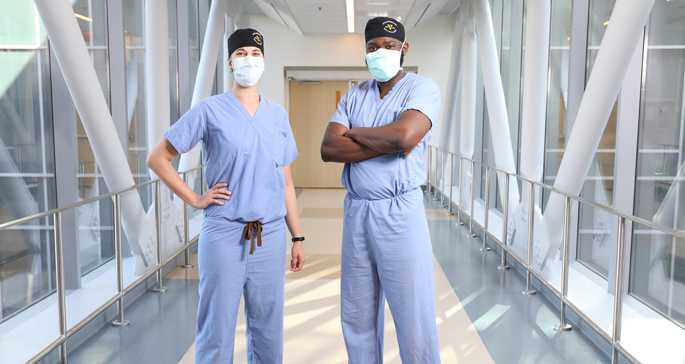
Brandon Esianor, MD, and Madelyn Stevens, MD, both residents in the Department of Otolaryngology-Head and Neck Surgery (O-HNS), have developed a virtual platform for O-HNS residency applicants across the country to connect with prospective residency programs.
The platform, called STAR OTO, stands for, “Short Talks by Aspiring Residents in Otolaryngology.” It provides an opportunity for aspiring residents to display their knowledge and showcase their interests by uploading brief five-minute videos, which can be viewed by participating residency programs across the country.
The videos consist of clinical topics, research interests or case discussions the student finds intriguing. Participants are encouraged to build on existing work with the goal of showcasing their efforts to a broader audience. So far, nearly 40 otolaryngology programs across the country used the platform in its inaugural year.
STAR OTO was first conceptualized by Esianor to address a need he saw when the pandemic hit. “When COVID first happened, everything was uncertain,” Esianor said. “We didn’t know how to proceed with interinstitutional initiatives, how to get students involved or how to create opportunities for medical students to interact with residency programs.”
Esianor was brainstorming ways to bridge the communication gap between students and faculty members when the STAR OTO initiative was born. “I felt like allowing students an opportunity to showcase their medical knowledge, but also a little about themselves and their interests, would give them the chance to be seen and be heard,” he said.
After dreaming up his initial idea for the platform, Esianor called his friend and co-resident, Stevens, to get her input. Stevens agreed the platform was a great idea and encouraged Esianor to create it, offering her help.
“Brandon called me with his idea, asking if I thought it was crazy,” Stevens said. “Of course, I didn’t think it was crazy. From that point on, we were able to build upon each other’s ideas and eventually create a place to highlight medical students’ hard work.”
An integral aspect of the platform is the ability for students to self-select volunteer faculty mentors from institutions across the country to receive interactive feedback on their presentation content prior to video submission.
Esianor calls this “short-term micro-mentoring” — mentoring relationships created with a smaller task in mind, such as creating and refining the five-minute videos, but that may expand into long-term mentorships after. “The goal is to connect students to faculty across the country and give them the chance to network with people whom they otherwise would not have had the chance to meet,” Stevens said.
Esianor and Stevens believe STAR OTO is a natural adjunct to the residency application process for two reasons: the first being that it offers a well-rounded and holistic view of students, allowing them to share personalized videos about their interests.
The second is its relevancy in an increasingly virtual world. STAR OTO creates a platform for students to build relationships with prominent faculty members at residency programs hundreds of miles away, whereas in the past they would have to make long and sometimes costly trips to build connections.
From initial idea to full launch, the STAR OTO platform was developed in under three months, thanks to strong support from the Department of Otolaryngology. “Unique times allow for creative solutions. STAR OTO, a hugely creative Vanderbilt program, was one of the O-HNS solutions offered this year to build relationships for the medical student applicants,” said Roland Eavey, MD, MS, Guy M. Maness Professor and chair of the department.
“To see participation from such a large national pool of applicants, such a national pool of mentors and such a substantial uptake by national programs was truly remarkable. Vanderbilt Tech Transfer is even considering the possibility of leveraging the idea into a formal company. Our hats go off to Madelyn and Brandon — and all our residents and attendings — for innovation to assist in the new reality of a pandemic,” Eavey continued.
To date, approximately 125 students have participated in the initiative. Esianor and Stevens hope the platform’s success serves as a proof of concept to eventually expand into different medical specialties.
“The positive response has been thrilling,” Stevens said. “Now that we’ve shown it was successful, we think the sky is the limit — even in a post-COVID world.”
“I’m excited to see how STAR OTO develops and grows over time,” Esianor added. “We believe it has an infinite amount of potential.”












